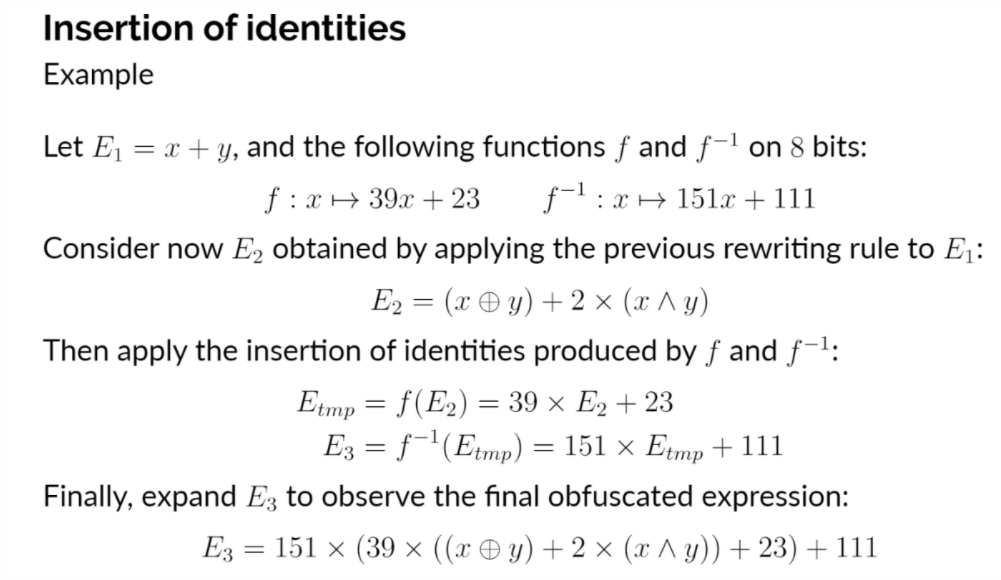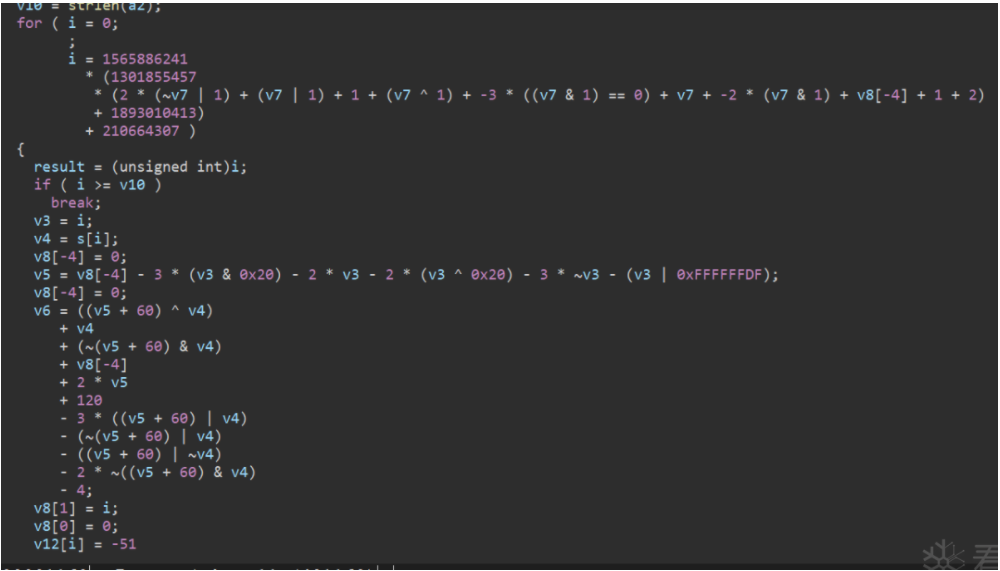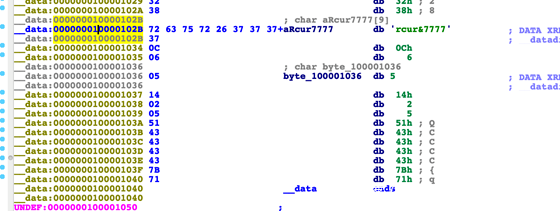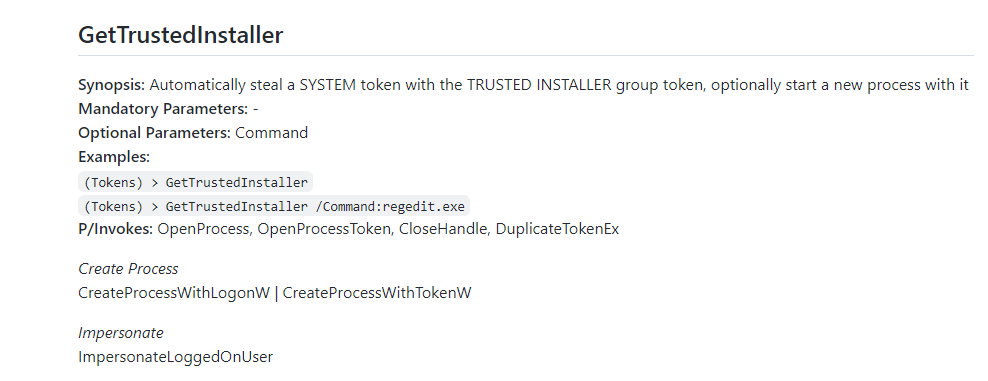本文介绍如何利用可逆多项式和线性MBA表达式构造多项式MBA表达式,并用LLVM Pass实现一种简单的多项式MBA混淆。
MATH WARNING: 本文涉及少量抽象代数知识,基本上都是网安专业信安数学必修课中学到的内容。推荐这篇文章《代数结构入门:群、环、域、向量空间》(https://zhuanlan.zhihu.com/p/21583674),总结得很好。
原论文:Information Hiding in Software with Mixed Boolean-Arithmetic Transforms
基本概念
定义在集合Z/(2^n)上的多项式集合Pm。n一般取32或者64,即系数和变量都为32位整数或64位整数的多项式:

定义集合Pm上的运算◦,◦即函数复合,例如f(x)◦g(x)=f(g(x))。集合Pm与运算◦构成一个群:

对于Pm中的多项式f(x),一定存在一个g(x),使得f(x)与g(x)满足f(x)◦g(x)=x或者说f(g(x))=x。g(x)可以通过以下公式来求解:

待会我们就要利用f(g(x))=x这一性质构造混淆表达式。
多项式求逆C语言实现
多项式求逆,即随机生成一个符合条件的多项式f(x),生成对应的逆多项式g(x)。主要就是套公式,并没有什么技术含量,不过公式有点复杂所以写起来也比较麻烦。
用到的有以下几个运算:求逆、求组合数、次方、相乘、求和、取反。这些运算都是在Z/(2^n)上的,也就是说运算结果都要模2^n。可以用flint2这个库来实现,代码如下:
#include "flint/fmpz_mod_poly.h"#include "flint/flint.h"#include #include #include #include using namespace std; int factorial(int n){ int fc=1; for(int i=1;i<=n;++i) fc *= i; return fc;} int combo(int n,int m){ return factorial(n) / (factorial(m) * factorial(n-m));} fmpz** gen_poly(int degree){ fmpz_mod_ctx ctx; fmpz n = 1LL << 32; fmpz_mod_ctx_init(&ctx, &n); fmpz_mod_poly_struct f, g; fmpz_mod_poly_init(&f, &ctx); fmpz_mod_poly_init(&g, &ctx); fmpz m = degree; fmpz *a = new fmpz[m + 1]; fmpz *b = new fmpz[m + 1]; fmpz a1_inv; fmpz *A = new fmpz[m + 1]; fmpz *A_sum = new fmpz[m + 1]; a[0] = rand(), a[1] = rand() | 1; for(int i = 2;i <= m;i ++){ a[i] = (rand() >> 16) << 16; } // Calculate a1_inv fmpz_mod_inv(&a1_inv, a + 1, &ctx); // Calculate A fmpz_mod_pow_ui(A + m, &a1_inv, m, &ctx); fmpz_mod_neg(A + m, A + m, &ctx); fmpz_mod_mul(A + m, A + m, a + m, &ctx); for(int k = m - 1; k >= 0;k --){ fmpz sum = 0; for(int j = k + 1;j <= m;j ++){ fmpz tmp; fmpz_mod_pow_ui(&tmp, a, j - k, &ctx); fmpz_mod_mul(&tmp, &tmp, A + j, &ctx); fmpz_mod_mul_ui(&tmp, &tmp, combo(j, k), &ctx); fmpz_mod_add(&sum, &sum, &tmp, &ctx); } fmpz_mod_pow_ui(A + k, &a1_inv, k, &ctx); fmpz_mod_mul(A + k, A + k, a + k, &ctx); fmpz_mod_neg(A + k, A + k, &ctx); fmpz_mod_sub(A + k, A + k, &sum, &ctx); A_sum[k] = sum; } // Calculate bm fmpz_mod_pow_ui(b + m, &a1_inv, m + 1, &ctx); fmpz_mod_neg(b + m, b + m, &ctx); fmpz_mod_mul(b + m, b + m, a + m, &ctx); // Calculate bk for(int k = 2;k < m;k ++){ fmpz_mod_pow_ui(b + k, &a1_inv, k + 1, &ctx); fmpz_mod_mul(b + k, b + k, a + k, &ctx); fmpz_mod_neg(b + k, b + k, &ctx); fmpz tmp; fmpz_mod_mul(&tmp, &a1_inv, A_sum + k, &ctx); fmpz_mod_sub(b + k, b + k, &tmp, &ctx); } // Calculate b1 fmpz sum = 0; for(int j = 2;j <= m;j ++){ fmpz tmp; fmpz_mod_pow_ui(&tmp, a, j - 1, &ctx); fmpz_mod_mul(&tmp, &tmp, A + j, &ctx); fmpz_mod_mul_ui(&tmp, &tmp, j, &ctx); fmpz_mod_add(&sum, &sum, &tmp, &ctx); } fmpz_mod_mul(&sum, &sum, &a1_inv, &ctx); fmpz_mod_sub(b + 1, &a1_inv, &sum, &ctx); // Calculate b0 b[0] = 0; for(int j = 1;j <= m;j ++){ fmpz tmp; fmpz_mod_pow_ui(&tmp, a, j, &ctx); fmpz_mod_mul(&tmp, &tmp, b + j, &ctx); fmpz_mod_add(b, b, &tmp, &ctx); } fmpz_mod_neg(b, b, &ctx); fmpz **coeff = new fmpz*[2]; coeff[0] = a, coeff[1] = b; delete[] A; delete[] A_sum; return coeff;} int main(){ int degree = 10; srand(time(NULL)); fmpz** coeff = gen_poly(degree); fmpz_mod_ctx ctx; fmpz n = 1LL << 32; fmpz_mod_ctx_init(&ctx, &n); fmpz_mod_poly_struct f, g, res; fmpz_mod_poly_init(&f, &ctx); fmpz_mod_poly_init(&g, &ctx); fmpz_mod_poly_init(&res, &ctx); for(int i = 0;i <= degree;i ++){ fmpz_mod_poly_set_coeff_ui(&f, i, coeff[0][i], &ctx); fmpz_mod_poly_set_coeff_ui(&g, i, coeff[1][i], &ctx); } fmpz_mod_poly_compose(&res, &g, &f, &ctx); flint_printf("f(x) = "); fmpz_mod_poly_print_pretty(&f, "x", &ctx); flint_printf(""); flint_printf("g(x) = "); fmpz_mod_poly_print_pretty(&g, "x", &ctx); flint_printf(""); flint_printf("g(f(x)) = "); fmpz_mod_poly_print_pretty(&res, "x", &ctx); flint_printf("");} 运行结果:
f(x) = 1756102656*x^10+947978240*x^9+368902144*x^8+1950089216*x^7+497156096*x^6+1583087616*x^5+178454528*x^4+202440704*x^3+932052992*x^2+421111353*x+593005452g(x) = 2268332032*x^10+395247616*x^9+2160525312*x^8+2187591680*x^7+3999137792*x^6+833880064*x^5+806682624*x^4+1138688000*x^3+2095448064*x^2+3762448393*x+1736062996g(f(x)) = x
flint2的整数(fmpz)是用signed long实现的,也就是说Z/(2^n)的n不能取64,因为2^64无法用signed long表示出来,所以这里选取的n是32:
fmpz_mod_ctx ctx;fmpz n = 1LL << 32;fmpz_mod_ctx_init(&ctx, &n);
如果只要生成degree为1,也就是f(x)和g(x)都为ax+b这种形式的式子,公式会简单很多,并且可以只用z3实现(安装flint2实在太麻烦了)。度数为1(即x的最高次方为1)的多项式求逆C语言代码如下:
#include "flint/fmpz_mod_poly.h"#include "flint/flint.h"#include "z3++.h"#include #include #include #include using namespace std;using namespace z3; uint64_t inverse(uint64_t n){ context c; solver s(c); expr a = c.bv_val(n, 64); expr a_inv = c.bv_const("a_inv", 64); s.add(a * a_inv == 1); s.check(); model m = s.get_model(); return m.eval(a_inv).get_numeral_uint64();} void gen_univariate_poly(uint64_t *a, uint64_t *b){ uint64_t a0, a1, b0, b1, a1_inv; a0 = ((uint64_t)rand() << 32) | rand(), a1 = ((uint64_t)rand() << 32LL) | (rand() | 1); // Calculate a1_inv a1_inv = inverse(a1); // Calculate b1 b1 = a1_inv; // Calculate b0 b0 = -(b1 * a0); uint64_t **coeff = new uint64_t*[2]; a[0] = a0, a[1] = a1, b[0] = b0, b[1] = b1;} 使用度数为1的多项式有几个好处,一是代码实现简单,二是用z3实现可以拓展到64位,三是混淆后对程序大小和速度的影响相对来说比较小。
所以接下来的混淆只会用度数为1的多项式。
混淆思路
虽然原论文提供了几种混淆思路,但我个人感觉都不太好用。后来我采用了这里提到的方法:

这里举了一个对x+y进行混淆的例子,大概的思路就是:
- 生成一对互逆的一次多项式f(x)和g(x)
- 构造与x+y等价的线性MBA表达式E2=(x^y)+2*(x&y)(关于什么是线性MBA表达式见我的上一篇文章)
- 构造E3=g(f(E2)),由之前提到过的性质,g(f(E2))实际上就等于E2
- 用等价但更复杂E3表达式替代原x+y表达式
LLVM Pass实现
线性MBA混淆的LLVM Pass实现也在上一篇文章提到过了,现在要介绍的多项式MBA混淆基于线性MBA混淆。
Github:
MBAObfuscation.cpp
MBAUtils.cpp
首先是把求逆多项式的代码移植一下,跟之前区别不大:
uint64_t inverse(uint64_t n, uint32_t bitWidth){ context c; solver s(c); expr a = c.bv_val(n, bitWidth); expr a_inv = c.bv_const("a_inv", bitWidth); s.add(a * a_inv == 1); s.add(a_inv != 0); s.check(); model m = s.get_model(); return m.eval(a_inv).get_numeral_uint64();} void generateUnivariatePoly(uint64_t *a, uint64_t *b, uint32_t bitWidth){ uint64_t a0, a1, b0, b1, a1_inv; a0 = cryptoutils->get_uint64_t(), a1 = cryptoutils->get_uint64_t() | 1; // Calculate a1_inv a1_inv = inverse(a1, bitWidth); // Calculate b1 b1 = a1_inv; // Calculate b0 b0 = -(b1 * a0); a[0] = a0, a[1] = a1, b[0] = b0, b[1] = b1;} 然后按照上述混淆思路,在线性MBA表达式的基础上插入多项式MBA混淆,代码如下,还是比较好理解的:
Value* llvm::insertPolynomialMBA(Value *linearMBAExpr, BinaryOperator *insertBefore){ IRBuilder<> builder(insertBefore->getContext()); builder.SetInsertPoint(insertBefore); Type *operandType = insertBefore->getOperand(0)->getType(); uint32_t bitWidth = operandType->getIntegerBitWidth(); uint64_t a[2], b[2]; generateUnivariatePoly(a, b, bitWidth); Value *expr; expr = builder.CreateMul(ConstantInt::get(operandType, b[1]), linearMBAExpr); expr = builder.CreateAdd(expr, ConstantInt::get(operandType, b[0])); expr = builder.CreateMul(ConstantInt::get(operandType, a[1]), expr); expr = builder.CreateAdd(expr, ConstantInt::get(operandType, a[0])); return expr;} 对加法进行替换的代码修改如下,其他的运算同理:
void MBAObfuscation::substituteAdd(BinaryOperator *BI){ int64_t *terms = generateLinearMBA(TermsNumber); terms[2] += 1; terms[4] += 1; Value *mbaExpr = insertPolynomialMBA(insertLinearMBA(terms, BI), BI); BI->replaceAllUsesWith(mbaExpr);} 混淆效果
源代码:
#include #include #include char *input;char enc[100] = "\x86\x8a\x7d\x87\x93\x8b\x4d\x81\x80\x8a\\x43\x7f\x49\x49\x86\x71\x7f\x62\x53\x69\x28\x9d";void encrypt(unsigned char *dest, char *src){ int len = strlen(src); for(int i = 0;i < len;i ++){ dest[i] = (src[i] + (32 - i)) ^ i; }}//flag{s1mpl3_11vm_d3m0}int main(int argc, char *argv[]){ printf("Welcome to LLVM world..."); if(argc <= 1){ printf("Input your flag as an argument."); return 0; } input = argv[1]; printf("Your flag is: %s", input); unsigned char dest[100] = {0}; encrypt(dest, input); bool result = strlen(input) == 22 && !memcmp(dest, enc, 22); if(result){ printf("Congratulations~"); }else{ printf("Sorry try again."); }} 混淆后:

转载请注明来自网盾网络安全培训,本文标题:《多项式MBA原理及其在代码混淆中的应用》
- 上一篇: 虚拟货币网络犯罪愈演愈烈 安全防护更要“多管齐下”
- 下一篇: 漏洞考古:MS08-067详细分析












